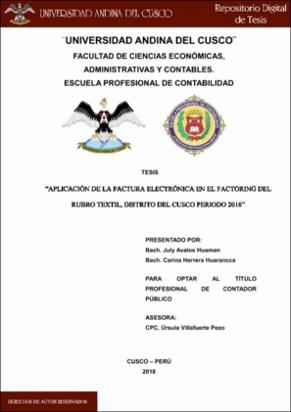| dc.contributor.advisor | Villafuerte Pezo, Úrsula Natalia | |
| dc.contributor.author | Avalos Huaman, July | |
| dc.contributor.author | Herrera Huarancca, Carina | |
| dc.date.accessioned | 2018-10-11T19:57:18Z | |
| dc.date.available | 2018-10-11T19:57:18Z | |
| dc.date.issued | 2018-05-16 | |
| dc.identifier.uri | https://hdl.handle.net/20.500.12557/1888 | |
| dc.description.abstract | El trabajo investigación intitulada “APLICACIÓN DE LA FACTURA ELECTRÓNICA EN EL FACTORING DEL RUBRO TEXTIL, DISTRITO DEL CUSCO PERIODO 2016”, consideramos que es relevante importancia determinar el nivel de aplicación de la factura electrónica en el factoring del rubro textil, que se encuentra situado en el distrito del Cusco y con una mayor concentración de estos en los locales de confecciones de la calle Tupac Amaru, ello nos permitirá saber si existe o no conocimiento y aplicación de este instrumento de liquidez mediante el uso de la factura electrónica. Teniendo el objetivo, determinar el nivel de aplicación de la factura electrónica en el factoring del rubro textil, distrito del Cusco periodo 2016 y la hipótesis que la aplicación de la factura electrónica en el factoring del rubro textil, distrito del Cusco periodo 2016, es mínimo. Tipo de investigación básica, enfoque cuantitativo, el diseño es no experimental y alcance descriptivo. Siendo la población y muestra de este trabajo de investigación las 24 empresas del rubro textil que se encuentran ubicadas en la calle Túpac Amaru del distrito del Cusco de los cuales tuvimos acceso a la información y se realizó el análisis de las variables factura electrónica y factoring. En cuanto al desarrollo del trabajo de investigación consideramos dentro del marco teórico información sobre el factoring y la factura electrónica detallando y analizando sus conceptos, características, las ventajas de estas variables y más datos, los cuales fundamentan la investigación. El análisis estadístico realizado nos indica que hay 1 empresa que aplica el factoring y 8 empresas la factura electrónica, lo que se considera como mínimo en cuanto a su aplicación. Llegamos a la siguiente conclusión: La aplicación de la factura electrónica en el factoring es mínima ya que un grupo menor de empresarios del rubro textil ubicados en la calle Túpac Amaru del distrito de Cusco, hacen uso de las factura electrónica y de la misma forma para la aplicación del factoring. | es_PE |
| dc.description.abstract | The research work entitled “APPLICATION OF THE ELECTRONIC INVOICE IN THE FACTORING OF THE TEXTILE SUBJECT, DISTRICT OF THE CUSCO PERIOD 2016“, we consider it important to determine the level of application of the electronic invoice in the factoring of the textile item, which is located in the district of Cusco and with a greater concentration of these in the clothing stores of Tupac Amaru street, this will allow us to know whether or not there is knowledge and application of this liquidity instrument through the use of electronic invoicing. Having the objective, to determine the level of application of the electronic invoice in the factoring of the textile item, district of Cusco period 2016 and the hypothesis that the application of the electronic invoice in the factoring of the textile item, district of Cusco period 2016, is minimum. Type of basic research, quantitative approach, design is non-experimental and descriptive scope. The population and sample of this research work are the 24 textile companies that are located in Tupac Amaru Street in the district of Cusco, of which we had access to information and the analysis of the variables electronic invoicing and factoring was carried out. Regarding the development of research work, we consider information on factoring and electronic invoicing within the theoretical framework, detailing and analyzing its concepts, characteristics, the advantages of these variables and more data, which are the basis of the research. The statistical analysis carried out indicates that there is 1 company that applies the factoring and 8 companies the electronic invoice, which is considered as a minimum in terms of its application. We come to the following conclusion: The application of electronic invoicing in factoring is minimal since a smaller group of textile entrepreneurs located on Túpac Amaru Street in the district of Cusco make use of electronic invoices and in the same way to the application of factoring. | en_US |
| dc.description.uri | Tesis | es_PE |
| dc.format | application/pdf | es_PE |
| dc.language.iso | spa | es_PE |
| dc.publisher | Universidad Andina del Cusco | es_PE |
| dc.rights | info:eu-repo/semantics/openAccess | es_PE |
| dc.rights.uri | https://creativecommons.org/licenses/by-nc-nd/2.5/pe/ | es_PE |
| dc.source | Universidad Andina del Cusco | es_PE |
| dc.source | Repositorio Institucional - UAC | es_PE |
| dc.subject | Factura electrónica | es_PE |
| dc.subject | Factoring | es_PE |
| dc.subject | Rubro textil | es_PE |
| dc.title | Aplicación de la factura electrónica en el factoring del rubro textil, distrito del Cusco periodo 2016. | es_PE |
| dc.type | info:eu-repo/semantics/bachelorThesis | es_PE |
| thesis.degree.name | Contador Público | es_PE |
| thesis.degree.grantor | Universidad Andina del Cusco. Facultad de Ciencias Económicas, Administrativas y Contables | es_PE |
| thesis.degree.level | Titulo Profesional | es_PE |
| thesis.degree.discipline | Contabilidad | es_PE |


